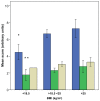Prevalence and correlates of dieting in college women: a cross sectional study
- PMID: 22956885
- PMCID: PMC3430089
- DOI: 10.2147/IJWH.S33920
Prevalence and correlates of dieting in college women: a cross sectional study
Abstract
Background: Dieting is a common practice among young women, irrespective of age, race, ethnicity, and weight. We aimed to determine the prevalence of dieting and its relationship with eating behavior, body weight, and body mass index (BMI) in college women.
Methods: This was a cross-sectional survey of female students aged 18-35 years (n = 308). Measures included BMI, restraint, disinhibition, hunger, dieting, weight loss, and perceived weight.
Results: A high percentage of college females consider themselves overweight or obese, despite having a BMI in the normal range. Dieting was practised by 43%, and 32% were avoiding weight gain, despite 78% having a healthy BMI. Women classified themselves as overweight or obese (27%), while only 11% were actually in these categories. Exercise was a common method of weight loss and positive associations were observed between dieting and BMI. Assessment of eating behavior showed that 27% were classified as high-restraint. Restraint and disinhibition were positively correlated with BMI.
Conclusion: Despite the widespread availability of nutrition information, there is incongruity in measured and perceived BMI in young educated women. Dieting practices and BMI are associated with restraint and disinhibition. Nutrition professionals should consider educating college women about healthy body weight regardless of their clients' BMI.
Keywords: body mass index; college women; dieting; eating behavior.
Figures

 ), rigid (
), rigid (
 ) and flexible restraint (
) and flexible restraint (
 ). Disinhibition and Rigid scores increase with increasing BMI category. Trend is statistically significant. *P < 0.001; **P < 0.05. Abbreviation: BMI, body mass index.
). Disinhibition and Rigid scores increase with increasing BMI category. Trend is statistically significant. *P < 0.001; **P < 0.05. Abbreviation: BMI, body mass index.Similar articles
-
Dieting practices, weight perceptions, and body composition: a comparison of normal weight, overweight, and obese college females.Nutr J. 2006 Mar 31;5:11. doi: 10.1186/1475-2891-5-11. Nutr J. 2006. PMID: 16579846 Free PMC article.
-
"Restrained eating" vs "trying to lose weight": how are they associated with body weight and tendency to overeat among postmenopausal women?J Am Diet Assoc. 2009 May;109(5):890-3. doi: 10.1016/j.jada.2009.02.009. J Am Diet Assoc. 2009. PMID: 19394476
-
Dieting, restraint, and disinhibition predict women's weight change over 6 y.Am J Clin Nutr. 2009 Jul;90(1):33-40. doi: 10.3945/ajcn.2008.26558. Epub 2009 May 13. Am J Clin Nutr. 2009. PMID: 19439461 Free PMC article.
-
Pediatric weight management, dietary restraint, dieting, and eating disorder risk: a systematic review.Nutr Rev. 2021 Sep 7;79(10):1114-1133. doi: 10.1093/nutrit/nuaa127. Nutr Rev. 2021. PMID: 33608718
-
[Assessing various aspects of the motivation to eat that can affect food intake and body weight control].Encephale. 2009 Apr;35(2):182-5. doi: 10.1016/j.encep.2008.03.009. Epub 2008 Jul 7. Encephale. 2009. PMID: 19393389 Review. French.
Cited by
-
Narcissism as a moderator of satisfaction with body image in young women with extreme underweight and obesity.PLoS One. 2015 May 11;10(5):e0126724. doi: 10.1371/journal.pone.0126724. eCollection 2015. PLoS One. 2015. PMID: 25961302 Free PMC article.
-
Thyroid axis adaptations to moderate short-term energy restriction in healthy, young women.Eur J Endocrinol. 2025 Apr 30;192(5):568-576. doi: 10.1093/ejendo/lvaf083. Eur J Endocrinol. 2025. PMID: 40265345 Clinical Trial.
-
Weight-loss strategies of South African female university students and comparison of weight management-related characteristics between dieters and non-dieters.BMC Public Health. 2016 Sep 1;16(1):918. doi: 10.1186/s12889-016-3576-x. BMC Public Health. 2016. PMID: 27586376 Free PMC article.
-
Inherited or Behavior? What Causal Beliefs about Obesity Are Associated with Weight Perceptions and Decisions to Lose Weight in a US Sample?Int Sch Res Notices. 2014 Sep 23;2014:632940. doi: 10.1155/2014/632940. eCollection 2014. Int Sch Res Notices. 2014. PMID: 27419204 Free PMC article.
-
Biological variability and impact of oral contraceptives on vitamins B(6), B(12) and folate status in women of reproductive age.Nutrients. 2013 Sep 16;5(9):3634-45. doi: 10.3390/nu5093634. Nutrients. 2013. PMID: 24067390 Free PMC article. Clinical Trial.
References
-
- Bish CL, Blanck HM, Serdula MK, Marcus M, Kohl HW, 3rd, Khan LK. Diet and physical activity behaviors among Americans trying to lose weight: 2000 Behavioral Risk Factor Surveillance System. Obes Res. 2005;13:596–607. - PubMed
-
- Kruger J, Galuska DA, Serdula MK, Jones DA. Attempting to lose weight: specific practices among US adults. Am J Prev Med. 2004;26:402–406. - PubMed
-
- Fonseca H, Matos MG, Guerra A, Pedro JG. Are overweight adolescents at higher risk of engaging in unhealthy weight-control behaviors? Acta Paediatr. 2009;98:847–852. - PubMed
LinkOut - more resources
Full Text Sources

